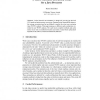DSD
2003
IEEE
14 years 5 months ago
2003
IEEE
With shrinking feature size of silicon fabrication technology, architects are putting more and more logic into a single die. While one might opt to use these transistors for build...
DATE
2003
IEEE
14 years 5 months ago
2003
IEEE
Modern embedded processors use data caches with higher and higher degrees of associativity in order to increase performance. A set–associative data cache consumes a significant...
DATE
2003
IEEE
14 years 5 months ago
2003
IEEE
In this paper we propose a design technique to pipeline cache memories for high bandwidth applications. With the scaling of technology cache access latencies are multiple clock cy...
CODES
2003
IEEE
14 years 5 months ago
2003
IEEE
Multitasked real-time systems often employ caches to boost performance. However the unpredictable dynamic behavior of caches makes schedulability analysis of such systems difficul...
PARA
2004
Springer
14 years 5 months ago
2004
Springer
Cache optimizations typically include code transformations to increase the locality of memory accesses. An orthogonal approach is to enable for latency hiding by introducing prefet...
OTM
2004
Springer
14 years 5 months ago
2004
Springer
Cache memories are mandatory to bridge the growing gap between CPU speed and main memory access time. Standard cache organizations improve the average execution time but are diffi...
ICS
2004
Tsinghua U.
14 years 5 months ago
2004
Tsinghua U.
Cache hierarchies have been traditionally designed for usage by a single application, thread or core. As multi-threaded (MT) and multi-core (CMP) platform architectures emerge and...
ICCS
2004
Springer
14 years 5 months ago
2004
Springer
In this paper, two tools are presented: an execution driven cache simulator which relates event metrics to a dynamically built-up call-graph, and a graphical front end able to visu...
ICCS
2004
Springer
14 years 5 months ago
2004
Springer
A cache oblivious matrix transposition algorithm is implemented and analyzed using simulation and hardware performance counters. Contrary to its name, the cache oblivious matrix tr...
ICCS
2004
Springer
14 years 5 months ago
2004
Springer
Abstract. For many applications, cache misses are the primary performance bottleneck. Even though much research has been performed on automatically optimizing cache behavior at the...






